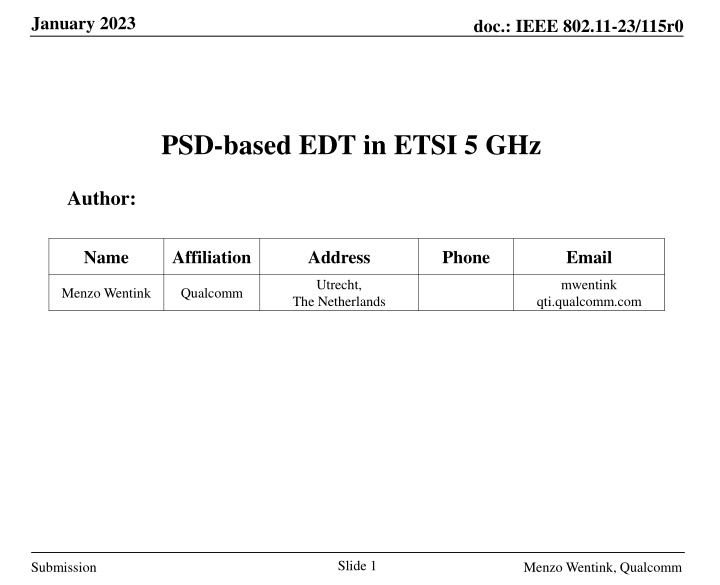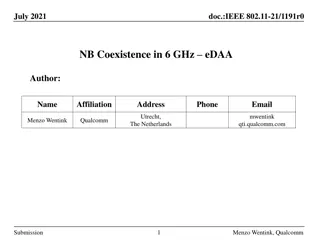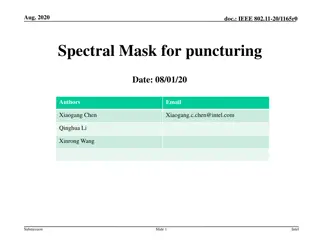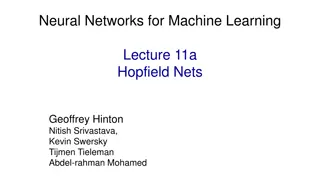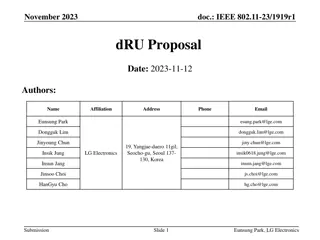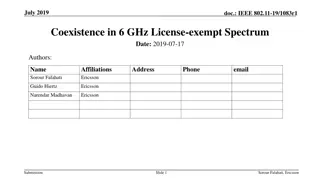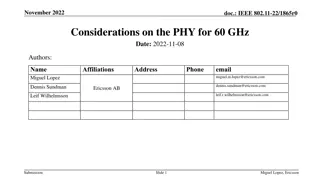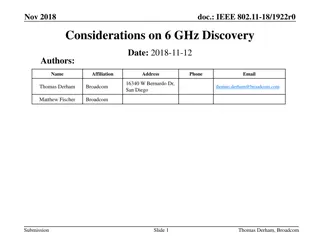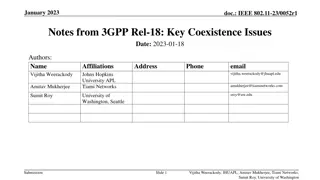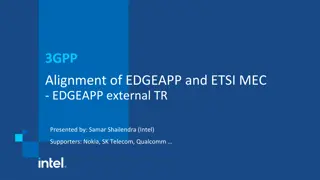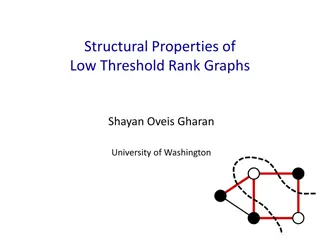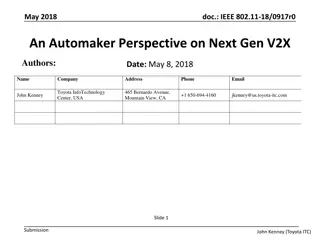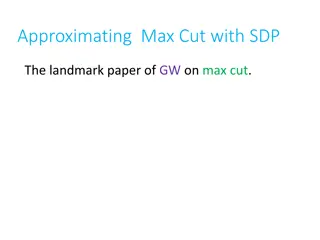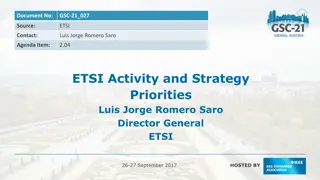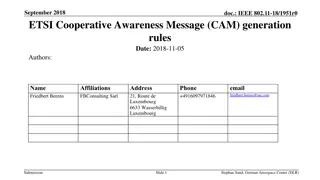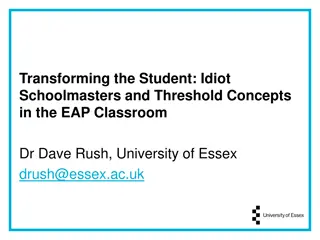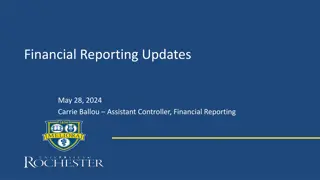PSD-based Energy Detect Threshold (EDT) in ETSI 5 GHz Standard
ETSI BRAN adopted a PSD-based EDT into the 5 GHz standard, specifying thresholds for energy detection levels. The new definition replaces the previous -72 dBm/20 MHz EDT, offering a compromise between power limits and channel configurations. Detailed examples and operational guidelines are provided for different bandwidth configurations. Additionally, a transition period is outlined for existing standards to adapt to the new EDT requirements.
Download Presentation

Please find below an Image/Link to download the presentation.
The content on the website is provided AS IS for your information and personal use only. It may not be sold, licensed, or shared on other websites without obtaining consent from the author.If you encounter any issues during the download, it is possible that the publisher has removed the file from their server.
You are allowed to download the files provided on this website for personal or commercial use, subject to the condition that they are used lawfully. All files are the property of their respective owners.
The content on the website is provided AS IS for your information and personal use only. It may not be sold, licensed, or shared on other websites without obtaining consent from the author.
E N D
Presentation Transcript
January 2023 doc.: IEEE 802.11-23/115r0 PSD-based EDT in ETSI 5 GHz Author: Name Affiliation Address Phone Email Utrecht, mwentink qti.qualcomm.com Menzo Wentink Qualcomm The Netherlands Slide 1 Submission Menzo Wentink, Qualcomm
January 2023 doc.: IEEE 802.11-23/115r0 ETSI 5 GHz PSD-based EDT definition In December 2022, ETSI BRAN adopted a PSD-based energy detect threshold (EDT) into the 5 GHz standard (EN 301 893 draft v2.1.50): The EDT shall be 85 dBm/MHz + (PSDlimit PSDmax) with a minimum of 85 dBm/MHz and a maximum of 75 dBm/MHz, where PSDmax is the maximum PSD when using all channels in the configured combination/grouping of channels and PSDlimit is the PSD limit in the sub-band of operation. [For simultaneous operation in more than 4 channels, 3 dB shall be added to PSDmax.] This is a compromise between -62 dBm/20 MHz and -72 dBm/20 MHz the new definition replaces the -72 dBm/20 MHz EDT that was in the standard before a PSD-based EDT reconciles the fact that the EDT in EN 301 893 applies per 20 MHz and that the power per 20 MHz depends on the configured BW Slide 2 Submission Menzo Wentink, Qualcomm
January 2023 doc.: IEEE 802.11-23/115r0 Examples of the PSD-based EDT For a device configured for 80 MHz operation at 23 dBm Tx power (PSDmax = 4 dBm/MHz) in subband 1 (where 23 dBm is the maximum power and 10 dBm/MHz is the regulatory PSD limit (PSDlimit = 10 dBm/MHz)): PSDmax = 4 dBm/MHz PSDlimit = 10 dBm/MHz EDT = 85 + (PSDlimit PSDmax) = 85 + (10 4) = 79 dBm/MHz = 66 dBm/20 MHz For a device configured for 20 MHz operation at 23 dBm Tx power (PSDmax = 10 dBm/MHz) in subband 1 (where 23 dBm is the maximum power and 10 dBm/MHz is the regulatory PSD limit (PSDlimit = 10 dBm/MHz)): PSDlimit = 10 dBm/MHz PSDmax = 10 dBm/MHz EDT = 85 + (PSDlimit PSDmax) = 85 + (10 10) = 85 dBm/MHz = 72 dBm/20 MHz Slide 3 Submission Menzo Wentink, Qualcomm
January 2023 doc.: IEEE 802.11-23/115r0 Overview of EDT levels The PSD-based rule results in the following EDT levels for operation at the regulatory power limit: Configured BW (MHz) EDT (dBm/20 MHz) 160 -63[-66] 80 -66 40 -69 20 -72 For operation below the regulatory max power, the EDT levels scale up accordingly, with a maximum of -62 dBm/20 MHz For a given configured BW, transmissions in lower BW can use the same EDT i.e. the EDT is not dynamic based on a per-TXOP PSD Slide 4 Submission Menzo Wentink, Qualcomm
January 2023 doc.: IEEE 802.11-23/115r0 Transition period 802.11ax and prior can keep using -62 dBm/20 MHz until ~2027 based on a minuted agreement in BRAN, which can be communicated with Notified Bodies the date is the date of withdrawal for EN 301 893 V2.1.1 which will be ~36 months after the next revision of EN 301 893 becomes listed in the OJEU 802.11be might be able to use -62 dBm/20 MHz until ~2027 this depends on whether Notified Bodies will agree to it, because the minuted agreement does not mention 11be Agreement on the transition period in BRAN(22)116e003r3: Guidance on EDT levels -- text for inclusion in the minutes of ETSI TC BRAN #117 With respect to IEEE 802.11ax equipment only, ETSI TC BRAN agrees that such equipment could be treated under the existing rules for option 1 EDT defined in EN 301 893 v2.1.1 clause 4.2.7.3.2.5 until the date of withdrawal of that standard. ETSI TC BRAN will contact the EC before ENAP to discuss the acceptance of an extension to the default date of withdrawal to at least 36 months after listing of the new version of the standard in the Official Journal. Slide 5 Submission Menzo Wentink, Qualcomm
January 2023 doc.: IEEE 802.11-23/115r0 Annex: ETSI 5 GHz regulatory PSD limits Slide 6 Submission Menzo Wentink, Qualcomm
